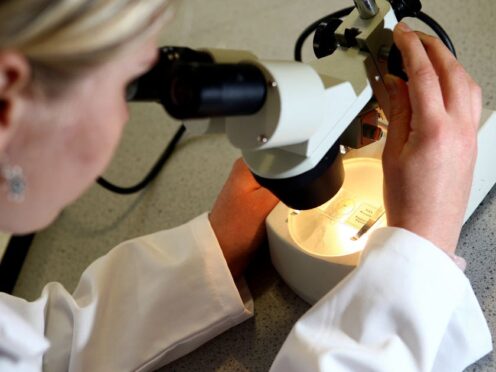
The UK is at risk of being “left behind” when it comes to heart disease research, a charity has warned.
Analysis by the British Heart Foundation (BHF) estimates there could be a shortfall of £250 million in the next decade, with patients and loved ones paying “the ultimate price”.
The charity has called on the Government for an uplift in funding for the condition, which causes heart attacks and stroke.
Research by the BHF found the Government will need to invest an additional £259 million in heart diseases research over the next 10 years to maintain spending at 2022 levels.
Dr Charmaine Griffiths, chief executive of the BHF, said: “Research breakthroughs have changed cardiovascular disease treatment and care beyond recognition since the 1960s, saving countless lives. But we can’t take this for granted.”
The BHF estimates that about 7.6 million people are living with heart and circulatory diseases in the UK.
It warned this figure could grow further due to an ageing population and better survival rates from the likes of heart attacks and strokes.
Deaths from heart and circulatory diseases account for about 27% of all deaths in the UK, the equivalent of 480 a day or one every three minutes.
Dr Griffiths added: “These findings should ring alarm bells for Government and prompt urgent action to prioritise cardiovascular disease research.
“A funding boost would be transformational, helping to reignite progress towards future discoveries so that more people can live longer lives in good health.”
The BHF claims charities are the largest funders in the field of cardiovascular research, which it warned is “unsustainable”.
According to a report by the UK Clinical Research Collaboration (UKCRC) in 2022, some 64% of the £106 million spent on research in the field came from charities.
The BHF alone contributed £85 million.
Professor Bryan Williams, chief scientific and medical officer at the BHF, said: “Thanks to the generosity of our supporters, the BHF has a proud legacy of funding pioneering research that has helped to save and improve millions of lives not only in the UK, but around the world.
“We’re committed to funding the best research and brightest minds to drive progress for people with cardiovascular disease.
“But relying on charities to fund so much research in one field is unsustainable.
“We’re in the midst of a scientific revolution and cardiovascular scientists need more funding to capitalise on the explosion of new technology and innovation. We can’t provide that alone.
“Without greater investment in cardiovascular disease research we’re in danger of being left behind, and it is patients and their loved ones who will pay the ultimate price.”
A Department of Health and Social Care spokesman said: “This government has already taken significant action to reduce cardiovascular disease and its causes.
“We are investing almost £17 million in an innovative new digital NHS health check, which is expected to deliver an additional one million health checks in its first four years, alongside investing just over £8 million this year into rolling out a pilot for workplace cardiovascular disease checks.
“We are exploring how we can improve outcomes for patients with cardiovascular disease as part of our forthcoming major conditions strategy, while our plans to create a smoke-free generation represent the most significant public health reform in living memory.”

Enjoy the convenience of having The Sunday Post delivered as a digital ePaper straight to your smartphone, tablet or computer.
Subscribe for only £5.49 a month and enjoy all the benefits of the printed paper as a digital replica.
Subscribe